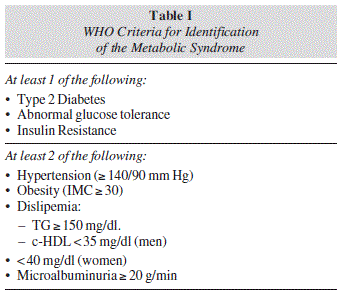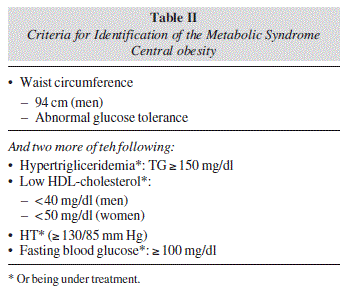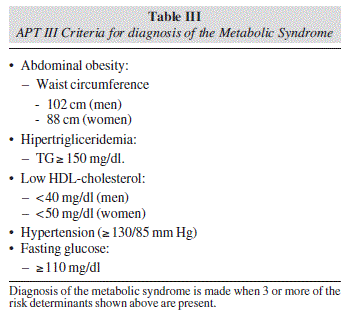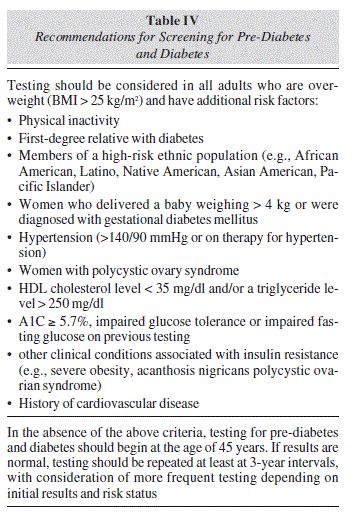Mi SciELO
Servicios Personalizados
Revista
Articulo
Indicadores
-
 Citado por SciELO
Citado por SciELO -
 Accesos
Accesos
Links relacionados
-
 Citado por Google
Citado por Google -
 Similares en
SciELO
Similares en
SciELO -
 Similares en Google
Similares en Google
Compartir
Nutrición Hospitalaria
versión On-line ISSN 1699-5198versión impresa ISSN 0212-1611
Nutr. Hosp. vol.28 supl.5 Madrid sep. 2013
CONSENSUS DOCUMENT AND CONCLUSIONS
Obesity and Diabetes
Obesidad y diabetes
Pilar Riobó Serván
Associated Head of Endocrinology and Nutrition Department. Fundación Jiménez Díaz Hospital. Madrid. Spain
ABSTRACT
Type 2 diabetes mellitus is characterized by hyperglycemia, insulin resistance, and relative impairment in insulin secretion and its possible long term complications. Its pathogenesis is poorly understood, but both genetic and environmental factors, such as obesity and aging, play a key role. "Diabesity" is a new term which refers to diabetes occurring in the context of obesity. In this article, we will discuss the epidemiology and impact of diabetes and obesity and will also outline the components of the metabolic syndrome and the studies that demonstrate that screening and prevention are possible in an attempt to control this epidemic.
Key words: Metabolic syndrome. Type 2 diabetes. Insulin resistance. Obesity.
RESUMEN
La diabetes tipo 2 se caracteriza por hiperglucemia, resistencia a la insulina y una relativa alteración en la secreción de insulina y por la posibilidad de complicaciones a largo plazo. Su patogénesis no está clara pero influyen tanto factores genéticos como ambientales, tales como la obesidad y el envejecimiento. Se ha acuñando un nuevo término, la "diabesidad" para definir la diabetes que se produce en el contexto de la obesidad. En este artículo se discuten la epidemiología y el impacto de la diabetes y obesidad, y también se describen los componentes del síndrome metabólico y los estudios que demuestran que el screening y la prevención son posibles, en un intento de controlar esta epidemia.
Palabras clave: Síndrome metabòlico. Diabetes tipo 2. Resistencia insulínica. Obesidad.
Abbrevations
MetS: Metabolic syndrome.
DM: diabetes mellitus.
IR: insulin resistance.
BMI: body mass index.
CVD: cardiovascular disease.
ESRD: end-stage renal disease.
IL: Interleuquin.
TNF: tumor necrosis factor.
HT: Arterial Hypertension.
NO: nitric oxide.
CRP: C reactive protein.
WHO: World Health Organization.
Introduction
Type 2 diabetes mellitus (DM) has become a highly prevalent disease all over the world and it has been recognized as a worldwide epidemic. The prevalence of both type 2 DM and obesity has increased worldwide during the last century, not only in developed countries, but also in developing countries, sometimes coexisting with undernutrition. Furthermore, the global prevalence of diabetes in 2010 was 280 million people worldwide (around 6.2% of the world's total population), and it has been predicted that in 2030 the prevalence will reach more than 7.5% of the world's total population, paralleling the aging and body mass index (BMI) of the population, thus confirming the relationship between obesity and diabetes. During the last 25 years, the prevalence of diabetes has doubled in the USA and multiplied by three to five times in Asian countries.1 Epidemiological data in Spain has shown a diabetes prevalence of between 5,5-18%, and a glucose intolerance prevalence of between 7,2-18%, depending on geographical location.
Diabesity
Obesity induces insulin resistance and involves a plethora of molecules that predispose individuals to an inflammatory state and metabolic complications. Insulin resistance is determined by genetic factors and also environmental factors as hyper-energetic and saturated and trans-fat high diet, obesity, aging and sedentarism. Diabesity is a new term referring to diabetes occurring in obese persons. A direct relationship between BMI and diabetes has been demonstrated. The pathogenesis has been demonstrated to be a resistance to insulin action in peripheral tissues. Insulin resistance can be defined as a state in which greater than normal amounts of insulin are required to produce a normal biological response. Insulin acts through coupling to a membrane cell receptor, a tetrameric protein with 2 identical alfa subunits and other 2 identical beta subunits. Alfa subunits are extracellular and after insulin coupling translate the signal to both intracellular beta subunits, which have tyrosine kinase activity, and are auto-phosphorilated, with a subsequent increase of their catalytic tyrosine kinase activity. Then, endogenous protein substrates are phospforilated and activate a cascade of intracellular signals, which in last term induce migration of glucose transporters (Glut-4) from intracellular pools to the cellular surface, to facilitate glucose entry into the cell. So, insulin resistance is due to an impairment in one or more of these steps of this process in the target-tissue, which induces compensating hyperinsulinemia to maintain normoglycemia. But along the years, pancreas gets exhausted and plasmatic glucose levels start to increase. Once glucose has increased, hyperglycemia has a toxic effect over islet cells (glucotoxicity) and has been demonstrated to impair the kinase function of insulin receptor ("down-regulation").
An important consequence of insulin resistance is the increase of free fatty acids, which in turn, impairs even more the insulin resistance (lipotoxicity). Even more, insulin resistance on hepatic, muscular and adipose tissue is associated with overproduction of proinflamatory citoquines, as interleuquin-6 (IL-6) and tumor necrosis factor (TNF), and a relative decrease of antinflamatory citoquines, as adiponectin. All these factors contribute to a chronic inflammatory status.
The health impact of type 2 DM is due to its long-term complications including cardiovascular diseases (CVD), stroke, peripheral vascular diseases, retinopathy, nephropathy, neuropathy. In Western countries, diabetes is the main cause of blindness and end-stage renal disease (ESRD), accounting for 40-50% of incident ESRD cases, and it doubles the possibility of CVD. It has been anticipated that due to increasing rates of childhood obesity in the USA, we may see the first generation which will be less healthy and have a shorter life expectancy than their parents, because of diabetic complications. Even more, diabetic patients had a significantly lower health-related quality of life in contrast to those without diabetes. The economic burden of diabesity is noteworthy, and it has a real impact on the world economy, as reflected by the consumption of about 14-15% of a country's total health expenditure,2 because of diabetic complications, with management of macrovascular disease being the largest and earliest.3 Even more, the burden of diabetes on the world economy has been increasing during the last decades, reaching at least $376 billion in 2010. Therefore, improving glycemic control of diabetes, or even better, avoiding diabetes by staying thin and fit, will prevent complications, and will reduce these high costs.
Metabolic Syndrome (MetS)
The rising prevalence of abdominal overweight and obesity has also a direct correlation with increasing prevalence of hypertension, dyslipidaemia. In 1998, Dr. Reaven defined metabolic syndrome (MetS), also known as X syndrome, as a conglomerate of coronary risk factors. It is characterized by the clustering of abdominal obesity, impaired glucose tolerance, elevated triglyceride levels, reduced high-density lipoprotein (HDL) cholesterol levels, and hypertension, often accompanied by a proinflammatory status that predisposes to CVD. Persons with MetS are at increased risk of type 2 DM and CVD. The waist perimeter can be used as an indirect, but effective marker of intraabdominal fat content, as it has been demonstrated to significantly correlate with it, quantified by radiological techniques. Over the years, several classifications for the MetS have been proposed by experts. The major definitions used are the WHO, National Cholesterol Education Program Adult Treatment Panel (NCEP ATP III),4 National Heart, Lung and Blood Institute/American Heart Association5 and International Diabetes Federation (IDF)6. These definitions differ somewhat in terms of the prerequisite components and the cut-off levels used for each component. WHO, IDF and NECP ATPIII and criteria for Identification of the Metabolic Syndrome are shown in Tables I, II and III, respectively. These last criteria have been widely accepted by its easy clinical applicability.
Other components of the MetS
Arterial Hypertension (HT) is often associated with obesity and increases the risk of CVD, even with minor elevations. Its prevalence is about 20-30% in general population, but if treated patients are included, it reaches about 44% of middle age adults. Insulin resistance decreases renal clearance of uric acid, so hyperuricemia can coexist. A proinflamatory status is underlying in the MetS, due to the overproduction of proinflamatory citoquines, as interleuquin-6 (IL-6), resistin, C reactive protein (CRP) and TNF, and a relative decrease of antinflamatory citoquines, as adiponectin, produced by adipose tissue. Plaquetar hyperagregability and hypercoagulation are also components of the metabolic syndrome, and predispose to a protrombotic status. Abnormalities in endothelial and vascular smooth muscle cell function, as well as a propensity to thrombosis, contribute to atherosclerosis and its complications. In normal endothelial cells, biologically active substances are synthesized and released to maintain vascular homeostasis, ensuring adequate blood flow and nutrient delivery while preventing thrombosis.7 One of these molecules synthesized by the endothelial cell is nitric oxide (NO) that causes vasodilation. In addition, NO protects the blood vessel from injury and atherosclerosis, by mediating molecular signals that prevent platelet and leukocyte interaction with the vascular wall and inhibit vascular smooth muscle cell proliferation. Endothelial dysfunction, as represented by impaired endothelium-dependent, NO-mediated relaxation, occurs in diabetes. Microalbuminuria is an early marker of endothelial dysfunction. Non-alcoholic fatty liver disease is the hepatic expression of metabolic syndrome, which comprises a spectrum of clinical and histological events ranging from simple and benign fatty liver to steatohepatitis, which is characterized by the abnormal activation of pathways leading to an aggressive inflammatory condition. Insulin resistance plays a key role and arises from multiple defects in the liver, adipose tissues, and muscle signaling, which leads to a failure to suppress hepatic gluconeogenesis and glycogenolysis, thereby enhancing fat accumulation in the hepatocytes via increased lipolysis and increased hepatic synthesis of triglycerides.
MetS prevalence is also growing at an alarming rate, and has also been defined as pandemic.8 In a compilation of observational studies conducted on European countries, it was reported that non-diabetic subjects under 40 years of age had an MS prevalence of 14-41 %, depending on the age range9. In the USA, a prevalence of 21.8% was found, which ranged from 6.7% (in 20 to 29-year olds) to 43.5% (in 60 to 69-year olds).10 Although less frequent than in Western countries, obesity and MetS are also major health problems in Asian populations. The prevalence of MetS in Japan was estimated at 25.3% for men and 10.6% for women. Results from different cross-sectional studies conducted in countries with emerging economies have reported that the prevalence of MS in these countries is also high. The general prevalence of MS in Latin-American countries was 24.9 %, and was slightly more frequent in women than in men.11 Globally, MetS affects 24% of all adults over 20 years of age, and the figure raises to 42% over 60 years of age.
Clinical importance of metabolic syndrome
MetS has been criticized because of the different definitions proposed. Since the WHO criteria in 1999, when insulin resistance was primordial, to NCEP ATP III, that priories abdominal obesity, or International Diabetes Federation (IDF) criteria in 2005. It has also been said that the criteria are incomplete and the etiology is not clearly understood. In some of the definitions, type 2 diabetic patients are not included. Even more, a specific treatment of MetS does not exist, but every one of the components must be treated separately. Even more, the cardiovascular risk of persons diagnosed is not higher than the associated to the risk factors. In this context, Dr. Reaven published in 2005 an article titled "Metabolic Syndrome: Requestiem in Pace".12 Nonetheless, the presence of a MetS is associated to 3.5 times higher mortality cardiovascular risk. And it is also doubtless that MetS has a clinical value, to implement an aggressive dietary treatment, and to treat the coexistent risk factors. The diagnosis of MetS amplifies the importance of obesity, hypertension or glucose and lipid alterations. As an example, hypertension is possible to be more severe, non dipper, and refractory to treatment, with microalbuminuria and more endothelial dysfunction. Anyways, no one can deny the good job of Gerald Reaven describing the unified concept of MetS, which has been translated to a big impulse, opening new ways to the basic, clinic, pharmacologic and epidemiologic research. This new concept has changed our knowledge about metabolic diseases and CVD.
But MetS detection is important because it allows for easy identification of patients who are at risk of developing atherosclerosis, type 2 diabetes mellitus and/or associated co-morbidities and who are subject to a higher mortality risk from these causes.13 Even more, individuals who are genetically predisposed to insulin resistance may forestall or even prevent the development of diabetes by staying thin and physically active. In addition, the concept of MetS facilitates the understanding of the underlying physiopathological relationships between its different components. This understanding may also be helpful for epidemiological and clinical studies associated with the treatment and/or prevention of CVD.
Diabetes prevention
In spite of new diabetes treatments, including sophisticated devices and continuous infusion pumps, obtaining an adequate metabolic control is a difficult challenge. Therefore, the goal would be to prevent diabetes. Although insulin resistance and type 2 diabetes have a genetic component, they can also be influenced by environmental factors. Weight reduction can substantially improve glycemic control in patients with type 2 diabetes, but there is also some evidence that weight loss can improve insulin resistance and prevent progression from IGT to type 2 diabetes.
Healthy lifestyle has been reported to reduce the incidence of new cases of type 2 diabetes in a subgroup of patients with impaired Glucose Tolerance (IGT), who have a high risk of developing diabetes.14 In The Malmo Prospective Study, performed in Sweden, a program of diet plus regular exercise improved glucose tolerance in the active group, who had a lower rate of progression to type 2 diabetes (11 versus 29%).15 The Finnish Diabetes Prevention Study, patients with impaired glucose tolerance (mean age 55 years, mean bMi 33.2) assigned to a weight-reduction and exercise program16 lost 3.5 kg (vs 0.8 kg in the control group) and the cumulative incidence of diabetes was significantly lower in the intervention group (11 versus 23%). Similar results were obtained in the Diabetes Prevention Program (DPP).17 In this study, 3,234 obese (average BMI 34 kg/m2) subjects, with high risk for diabetes due to impaired glucose tolerance, were randomly assigned to one of the following groups: 1) Intensive lifestyle changes through a low-fat diet and exercise for 150 minutes per week. 2) Treatment with metformin plus information on diet and exercise, 3) Control group with placebo plus information on diet and exercise. The diet and exercise group lost an average 7 percent of weight in the first year, most of which was sustained through the duration of the study. After 3 years, fewer patients in this group developed diabetes (14% versus 22% and 29% in the metformin and placebo groups, respectively). After 2.8 years follow-up, 58% reduction in metformin group was observed. Improvements in insulin sensitivity and insulin secretion, greatest in the intensive lifestyle intervention group, and somewhat lower in the metformin group, correlated directly with decreased risk of diabetes.18
Lifestyle intervention may also be effective in individuals without impaired glucose tolerance in the MRFIT.19 In this large primary prevention trial, an intervention (advice on diet, exercise, giving up smoking, and intensive blood pressure treatment) in men at high risk for coronary heart disease was associated with a lower risk of type 2 diabetes in the nonsmokers.
But, although effectiveness of lifestyle intervention has been clearly demonstrated, the dietary and exercise changes may be difficult to implement in the real world. Long term compliance with dietary interventions has been poor, and new, less expensive strategies must be found to achieve long-term weight loss. The "real-world" implementation of lifestyle interventions is a challenge. The Good Ageing in Lahti Region (GOAL) Lifestyle Implementation Trial20 was designed for the primary health care setting in Finland, with lifestyle and risk reduction objectives derived from the major diabetes prevention efficacy trials. A total of 352 middle-aged participants with elevated type 2 diabetes risk were recruited. The intervention included six group counseling sessions, delivered by nurses. At baseline, mean BMI was 32 kg/m2, and 25% of the participants had impaired glucose tolerance. After 12 months, 20% of participants achieved at least four of five key lifestyle outcomes. Therefore, this trial demonstrates that lifestyle counseling can be effective and is feasible in real-world settings for individuals with elevated risk of type 2 diabetes.
Challenges and opportunities
Prevention of diabetes is crucial to lowering diabetes incidence, and thus minimizing the health burden. At the time of diagnosis, 50% of patients have microvascular complications (retinopathy, neuropathy or nephropathy) and twice the risk of macrovascular complications compared to the general population. Obesity is the most important modifiable factor, accounting for more than half of new diabetes' cases.21 Even modest weight loss has a favorable effect in preventing the appearance of diabetes. Also, physical exercise with or without diet contributes to a healthier lifestyle, and is important for lowering risk.22 The best way to contain this epidemic is to screen for early detection, prevention and management of obesity, especially in younger individuals, before the development of type 2 DM. In table IV the American Diabetes Association recommendations for type 2 DM screening23 are shown. Risk factors include family history, hypertension, obesity, sedentary lifestyle, smoking and hyperlipidaemia. Screening should be done for high risk individuals using fasting plasma glucose (FPG). An FPG <126 mg/dL (7.0 mmol/L) in an individual with a high suspicion for diabetes should be followed by a OGTT to confirm diabetes.
In 2010 the American Heart Association (AHA) announced its new Strategic Impact Goals: "by 2020, to improve the cardiovascular health of all Americans by 20% while reducing deaths from cardiovascular diseases and stroke by 20%".24 The novel aspect of the 2020 goals is the promotion of "cardiovascular health", a new, positive approach to prevention of CVD, including smoking status, BMI, dietary content, participation in physical activity, and levels of blood pressure, blood glucose, and total cholesterol. Hopefully, these goals will imply a decrease in obesity, type 2 DM, and MetS.
Conclusion
Diabesity and MetS have become a worldwide epidemic with a significant health and economic burden affecting both developed and developing countries. It seems possible to reduce the burden of diabetes. Clinical trials have convincingly shown that lifestyle modification is the most effective tool in the prevention or delay of type 2 diabetes. For overweight and obese patients, a modest weight-loss goal of 5-10% can substantially reduce diabetes risk. Moderate-intensity physical activity such as brisk walking for at least 150 minutes per week also plays an important role in reducing diabetes risk, even in the absence of weight loss. Therefore, prevention of diabetes should be a priority, and successful implementation of these proven strategies should be the focus of our efforts. We have a lot to do.
References
1. Yang W, Lu J, Weng J, et al. Prevalence of diabetes among men and women in China. N Engl J Med 2010; 362: 1090-101. [ Links ]
2. Farag MKY, Gaballa MR. Diabesity: an overview of a rising epidemic. Nephrol Dial Transplant 2011; 26: 28-35. [ Links ]
3. Caro JJ, Ward AJ, O'Brien JA. Lifetime Costs of Complications Resulting From Type 2 Diabetes in the U.S. Diabetes Care 2002; 25: 476-81. [ Links ]
4. National Institute of Health: Third report of the National Cholesterol Education Program (NCEP) Expert Panel Detection, Evaluation, and Treatment of High Blood cholesterol in Adults (Adult Treatment Panel III) final report. Circulation 2002; 106: 3143-421. [ Links ]
5. Grundy SM, Cleeman JI, Daniels SR, Donato KA, Eckel RH, Franklin BA, et al, American Heart Association; National Heart, Lung, and Blood Institute. Diagnosis and management of the metabolic syndrome: an American Heart Association/ National Heart, Lung, and Blood Institute Scientific Statement. Circulation 2005; 112: 2735-52. [ Links ]
6. Alberti K, Zimmet P, Shaw J. Metabolic syndrome-a new world-wide definition. A consensus statement from the International Diabetes Federation. Diabet Med 2006; 23: 469-80. [ Links ]
7. Creager MA, Lüscher, TF. Diabetes and Vascular Disease. Pathophysiology, Clinical Consequences, and Medical Therapy: Part I. Circulation 2003; 108: 1527-32. [ Links ]
8. Grundy SM. Metabolic syndrome pandemic. Arterioscler Thromb Vasc Biol 2008; 28: 629-36. [ Links ]
9. Balkau B, Charles MA, Drivsholm T, et al. Frequency of the WHO metabolic syndrome in European cohort, and an alternative definition of an insulin resistance syndrome. Diabetes Metab 2002; 28: 364-76. [ Links ]
10. Ford ES, Mokdad AH, Giles WH, et al. Serum total cholesterol concentrations and awareness, treatment, and control of hyper-cholesterolemia among US adults: findings from the National Health and Nutrition Examination Survey, 1999 to 2000. Circulation 2003;107:2185-9. [ Links ]
11. Márquez-Sandoval F, Macedo-Ojeda G, Viramontes-Horner D, Fernández JD, Salas J, Vizmanos B. The prevalence of metabolic syndrome in Latin America: a systematic review Public Health Nutrition. doi:10.1017/S1368980010003320. [ Links ]
12. Reaven GM. The metabolic syndrome: requiescat in pace. Clin Chem 2005; 51: 931-8. [ Links ]
13. Grundy SM. Metabolic syndrome: a multiplex cardiovascular risk factor. J Clin Endocrinol Metab 2007; 92: 399-404. [ Links ]
14. Hu G, Lindstrom J, Valle TT, et al. Physical activity, body mass index, and risk of type 2 diabetes in patients with normal or impaired glucose regulation. Arch Intern Med 2004; 164: 892-6. [ Links ]
15. Eriksson, KF, Lindgarde, F. Prevention of type 2 (non-insulin-dependent) diabetes mellitus by diet and physical exercise. The 6-year Malmo feasibility study. Diabetologia 1991; 34: 891. [ Links ]
16. Tuomilehto J, Lindstrom J, Eriksson JG, et al. Prevention of type 2 diabetes mellitus by changes in lifestyle among subjects with impaired glucose tolerance. N Engl J Med 2001; 344: 1343-50. [ Links ]
17. Knowler WC, Barrett-Connor E, Fowler SE, et al. Reduction in the incidence of type 2 diabetes with lifestyle intervention or metformin. N Engl J Med 2002; 346: 393. [ Links ]
18. Kitabchi AE, Temprosa M, Knowler WC, et al. Role of insulin secretion and sensitivity in the evolution of type 2 diabetes in the diabetes prevention program: effects of lifestyle intervention and metformin. Diabetes 2005; 54: 2404. [ Links ]
19. Davey Smith, G, Bracha Y, Svendsen KH, et al. Incidence of type 2 diabetes in the randomized multiple risk factor intervention trial. Ann Intern Med 2005; 142: 313. [ Links ]
20. Absetz P, Valve R, Oldenburg B. Type 2 Diabetes Prevention in the "Real World". One-year results of the GOAL Implementation Trial. Diabetes Care 2007; 30: 2465-70. [ Links ]
21. Anderson JW, Kendall CW, Jenkins DJ. Importance of weight management in type 2 diabetes: Review with meta-analysis of clinical studies. J Am Coll Nutr 2003; 22: 331-9. [ Links ]
22. Psaltopoulou T, Ilias J, Alevizaki M. The Role of Diet and Lifestyle in Primary, Secondary, and Tertiary Diabetes Prevention: A Review of Meta-Analyses. Rev Diabet Stud 2010; 7: 26-35. [ Links ]
23. American Diabetes Association: Standards of medical care in diabetes. Diabetes Care 2010; 32: S11-61. [ Links ]
24. Lloyd-Jones DM, Hong Y, Labarthe D, et al, American Heart Association Strategic Planning Task Force and Statistics Committee. Defining and setting national goals for cardiovascular health promotion and disease reduction: the American Heart Association's Strategic Impact Goal through 2020 and beyond. Circulation 2010; 121 (4): 586-613. [ Links ]
![]() Correspondence:
Correspondence:
Pilar Riobó Serván
Associates Head of Endocrinology and Nutrition Department
Cea Bermúdez, 65
Fundación Jiménez Díaz Hospital. Madrid. Spain
E-mail: priobo@telefonica.net


















